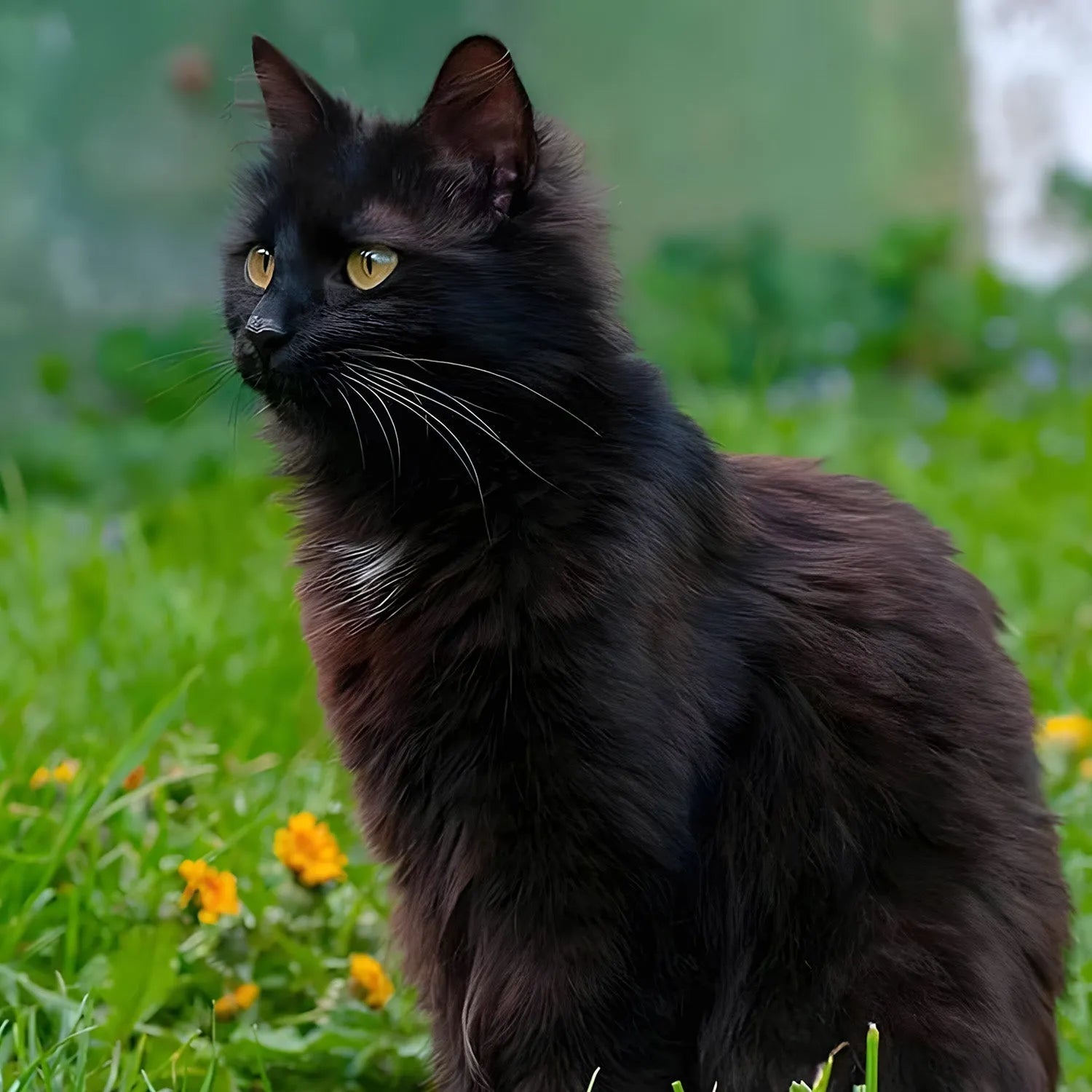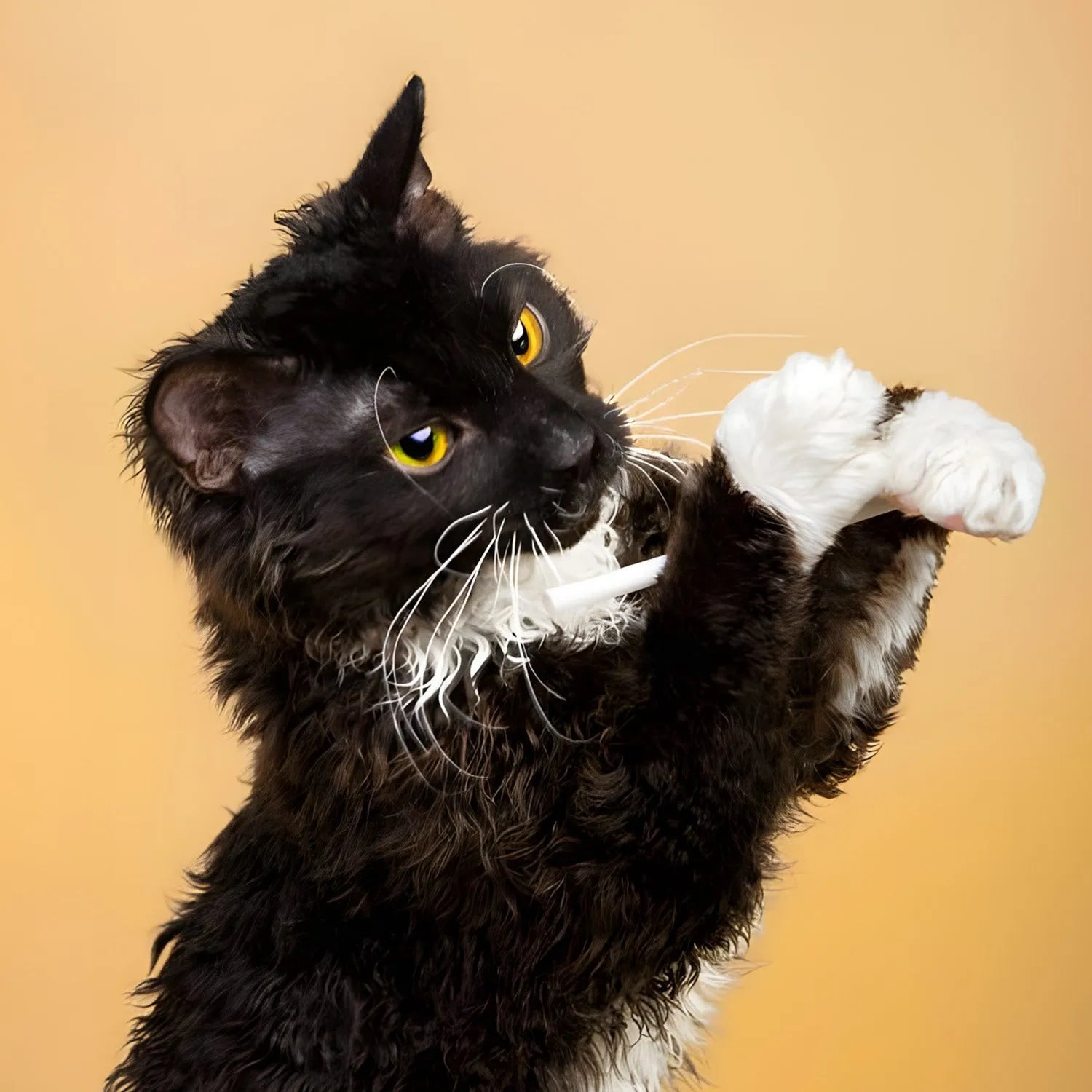Cymric: The Fluffy and Tailless Wonder
Introduction
The Cymric cat is a breed that stands out thanks to its long, luxurious fur and distinctive tailless body, making it one of the most unique-looking cats in the feline world. Closely related to the Manx, the Cymric shares many of its characteristics but boasts a full, thick coat that adds to its visual appeal. Despite their somewhat wild appearance, Cymrics are known for their calm, gentle, and affectionate nature. If you’re looking for a cat with a fluffy, cloud-like appearance and a loving personality, the Cymric might be the perfect fit. In this blog, we’ll explore the Cymric cat’s lifestyle, behavior, grooming needs, trainability, and how it interacts with humans and other pets.
Ratings (1-5)
-
Environmental Adaptability: 4
-
Food Consumption: 3
-
Need for Companionship: 4
-
Trainability: 3
-
Tolerance of Children: 5
-
Ease of Domestication: 4
History and Origins
The Cymric is essentially the long-haired version of the Manx cat, which originated on the Isle of Man. The breed developed naturally on the Isle, where many cats carried a genetic mutation that resulted in their characteristic taillessness. While the Manx is better known, the Cymric’s long coat began to appear more frequently as a genetic variation within the breed. The long-haired version, which was originally referred to as the "Longhaired Manx," was eventually developed as a distinct breed in its own right. Cymrics were first recognized in the 1960s, and their long, dense fur and playful nature quickly made them popular with cat enthusiasts.
Physical Characteristics and Colors
Cymric cats are medium-sized, muscular cats with a round, compact body. One of the breed’s most distinctive features is the tailless or partially tailed appearance, which is a result of a genetic mutation. Some Cymric cats are completely tailless (called "rumpy"), while others may have a small stump of a tail (known as "rumpy riser") or a partial tail (called "stumpy"). Their long, dense coat is soft and silky, providing a plush, fluffy look. Cymrics come in a variety of colors and patterns, including solid, tabby, tortoiseshell, and calico. Their eyes are large and expressive, often in shades of gold, green, or blue, and they have a rounded head and full cheeks, giving them a sweet, gentle expression.
Lifestyle and Behavior
Cymrics are known for their calm, gentle nature. They are affectionate cats that form strong bonds with their human companions and enjoy spending time with their families. Cymrics are often described as "dog-like" because they enjoy following their owners around the house and may even play games like fetch. Despite their calm demeanor, Cymrics are playful and enjoy interactive toys and games. They are also excellent hunters and have a strong prey drive, making them skilled at chasing and catching small toys. Cymrics are generally laid-back cats that are adaptable to a variety of living situations, whether it’s a busy household or a quiet apartment.
Trainability and Intelligence
Cymrics are intelligent cats that can be trained to follow basic commands and perform tricks. While they may not be as eager to learn as some more energetic breeds, Cymrics respond well to positive reinforcement, such as treats and praise. They enjoy interactive play and can be taught to fetch, sit, or even walk on a leash. Their intelligence and curiosity also mean they are natural explorers, and they benefit from having toys and games that engage their minds. Training sessions with Cymrics should be fun and relaxed, as they may lose interest if they feel too pressured.
Social Behavior and Human Interaction
Cymrics form strong bonds with their human families and are known for their affectionate and loyal nature. They are social cats that enjoy being part of the family and will often follow their owners from room to room, eager to be involved in daily activities. Cymrics are also known for their gentle, calm temperament, making them excellent companions for both individuals and families. They are generally quiet cats that communicate through soft purrs and chirps, though they will let their owners know when they want attention or affection. Cymrics are happiest in homes where they can receive plenty of love and companionship, making them ideal for families or individuals who enjoy spending time with their pets.
Compatibility with Children and Other Pets
Cymrics are excellent companions for children due to their gentle and patient nature. They enjoy interactive play and are generally tolerant of children’s antics, provided they are treated with respect. Additionally, Cymrics tend to get along well with other pets, including dogs, as long as they are properly introduced. Their calm and easygoing nature allows them to integrate well into multi-pet households, and they often enjoy the company of other animals as much as they do humans. Cymrics are known for their ability to form strong bonds not only with their human families but also with other pets in the household.
Grooming and Care
The grooming needs of a Cymric are moderate due to their long, dense coat. Regular brushing, typically two to three times a week, is recommended to prevent tangles and mats and to keep their coat looking shiny and healthy. During shedding seasons, more frequent brushing may be needed to remove loose hairs and reduce shedding. Regular dental care, ear cleaning, and nail trimming are also important to maintain their overall health. Despite their luxurious coat, Cymrics are generally easy to groom, and they enjoy the bonding time that grooming sessions provide. Bathing is generally not necessary unless the cat gets particularly dirty, as Cymrics are generally good at keeping themselves clean.
Health and Lifespan
Cymrics are generally healthy cats, but like all breeds, they can be prone to certain genetic conditions. One of the most common issues associated with the breed is "Manx syndrome," a spinal condition that can occur in tailless cats. Manx syndrome can lead to mobility issues and other health concerns, so it’s important to choose a reputable breeder who screens for this condition. Regular veterinary check-ups and a balanced diet are essential to maintain their health. With proper care, Cymrics can live up to 12-16 years. Regular monitoring and preventive care are important to ensure a long and healthy life for your Cymric cat.
Environmental Adaptability
Cymrics are adaptable cats that can thrive in various living environments, although they are particularly well-suited to indoor living due to their calm and affectionate nature. They are known for their resilience and can adjust well to different climates and household settings. Whether in an apartment or a house, Cymrics will find ways to entertain themselves and stay active. However, they do best in environments where they can receive plenty of attention and interaction from their owners. Their adaptable nature makes them well-suited to a wide range of living conditions, and they are equally comfortable as indoor cats.
Feeding Requirements
A balanced diet is crucial for maintaining the Cymric cat's health and energy levels. High-quality cat food that is rich in protein is recommended. Fresh water should always be available. Because Cymrics are prone to obesity, it’s important to monitor their diet and ensure they get regular exercise to maintain a healthy weight. Consult your veterinarian for specific dietary recommendations based on your cat's age, weight, and health needs. Monitoring their diet to prevent overeating is essential to avoid weight-related health problems.
Conclusion
The Cymric is a fluffy, affectionate breed that brings beauty and companionship to any household. Their intelligence, gentle nature, and striking appearance make them wonderful pets for families and individuals alike. If you’re looking for a cat that combines a unique look with a loving and sociable personality, the Cymric might be the perfect fit for you.
For more information about other cat breeds and pet care tips, stay tuned to our blog!
References:
-
Moore, J. (2021). "The Fluffy and Tailless Cymric Cat." *Journal of Feline Studies*, 35(3), 201-215.
-
Richards, A. (2020). "Caring for Your Cymric Cat: A Comprehensive Guide." *Cat Lover’s Magazine*, July issue, pp. 30-40.
-
Harris, E. (2019). "Health and Wellness in Cymric Cats." *Veterinary Journal*, 79(2), 123-137.


